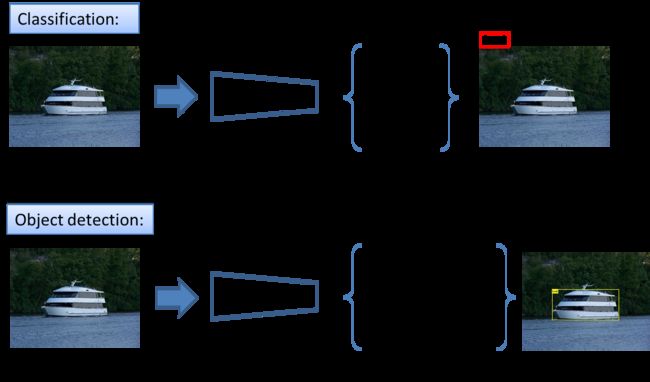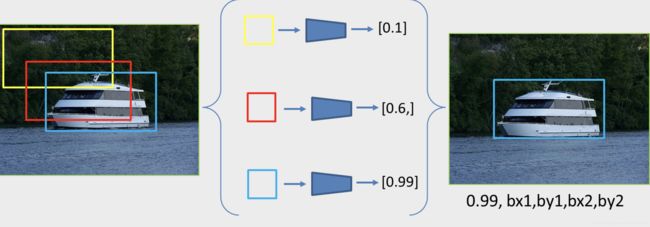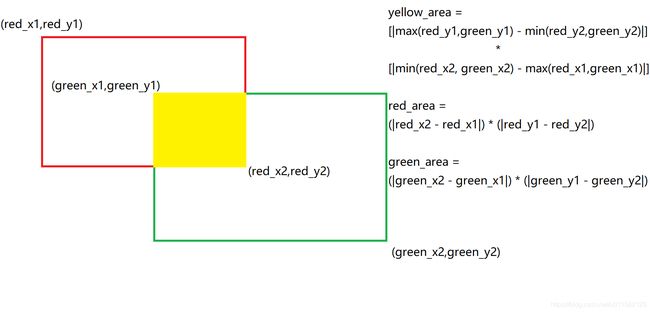DataWhale计算机视觉实践(目标检测)Task01
DataWhale计算机视觉实践(目标检测)Task01
文章目录
- DataWhale计算机视觉实践(目标检测)Task01
-
- 目标检测:
-
- 一、基本概念:
- 二、目标检测数据集VOC:
-
- 1. VOC数据集简介
- 2. VOC数据集的`dataloader`的构建
文中图片和部分内容、代码转自:动手学CV-Pytorch
目标检测:
一、基本概念:
目标检测,也叫目标提取,是一种基于目标几何和统计特征的图像分割,它将目标的分割和识别合二为一,其准确性和实时性是整个系统的一项重要能力。尤其是在复杂场景中,需要对多个目标进行实时处理时,目标自动提取和识别就显得特别重要。百度百科
- 图像分类和目标检测的区别:
-
图像分类:只需要判断输入的图像中是否包含感兴趣物体。
-
目标检测:需要在识别出图片中目标类别的基础上,还要精确定位到目标的具体位置,并用外接矩形框标出。
-
- 目标检测的思路:
即定义大量的候选框,计算每一个候选框中基于分类网络得到的得分(代表当前框中有某个物体的置信度),最终得分最高的就代表识别的最准确的框,其位置就是最终要检测的目标的位置。
**先确立众多候选框,再对候选框进行分类和微调。**(RCNN、YOLO、SSD等经典网络模型思路。)
-
目标框定义方式:
- 图像分类:标签信息是类别。
- 目标检测:类别label,目标的位置信息(目标的外接矩形框bounding box)
- bbox的格式通常有两种:
(x1,y1,x2,y2)和(x_c,y_c,w,h)。
- bbox的格式通常有两种:
- 两种定义方式也可以进行互转,代码如下:
import torch
# 两种不同的目标框信息表达格式互转
def xy_to_cxcy(xy):
"""
Convert bounding boxes from boundary coordinates (x_min, y_min, x_max, y_max) to center-size coordinates (c_x, c_y, w, h).
:param xy: bounding boxes in boundary coordinates, a tensor of size (n_boxes, 4)
:return: bounding boxes in center-size coordinates, a tensor of size (n_boxes, 4)
"""
return torch.cat([(xy[:, 2:] + xy[:, :2]) / 2, # c_x, c_y
xy[:, 2:] - xy[:, :2]], 1) # w, h
def cxcy_to_xy(cxcy):
"""
Convert bounding boxes from center-size coordinates (c_x, c_y, w, h) to boundary coordinates (x_min, y_min, x_max, y_max).
:param cxcy: bounding boxes in center-size coordinates, a tensor of size (n_boxes, 4)
:return: bounding boxes in boundary coordinates, a tensor of size (n_boxes, 4)
"""
return torch.cat([cxcy[:, :2] - (cxcy[:, 2:] / 2), # x_min, y_min
cxcy[:, :2] + (cxcy[:, 2:] / 2)], 1) # x_max, y_max
- 交并比(IoU):
IoU:Intersection over Union
- 贯穿整个模型的训练测试和评价过程,目的是用来衡量两个目标框的重叠程度。
- 表示两个目标框的交集占其并集的比例。
I o U = i n t e r s e c t i o n u n i o n IoU = \frac{intersection}{union} IoU=unionintersection
计算流程:
1.首先获取两个框的坐标,红框坐标: 左上(red_x1, red_y1), 右下(red_x2, red_y2),绿框坐标: 左上(green_x1, green_y1),右下(green_x2, green_y2)
2.计算两个框左上点的坐标最大值:(max(red_x1, green_x1), max(red_y1, green_y1)), 和右下点坐标最小值:(min(red_x2, green_x2), min(red_y2, green_y2))
3.利用2算出的信息计算黄框面积:yellow_area
4.计算红绿框的面积:red_area和green_area
5.IoU = yellow_area / (red_area + green_area - yellow_area)
- IoU计算实现代码如下所示:
# 计算IoU
def find_intersection(set_1, set_2):
"""
Find the intersection of every box combination between two sets of boxes that are in boundary coordinates.
:param set_1: set 1, a tensor of dimensions (n1, 4) [x_1,y_1,x_2,y_2]
:param set_2: set 2, a tensor of dimensions (n2, 4) [x_1,y_1,x_2,y_2]
:return: 返回交集的面积intersection of each of the boxes in set 1 with respect to each of the boxes in set 2, a tensor of dimensions (n1, n2)
"""
# PyTorch auto-broadcasts singleton dimensions
# 计算出交集的左上角坐标max((red_x1, green_y1),(green_x1,red_y1))
lower_bounds = torch.max(set_1[:, :2].unsqueeze(1), set_2[:, :2].unsqueeze(0)) # (n1, n2, 2)
# 计算出交集的右下角坐标min((red_x2, red_y2), (green_x2, green_y2))
upper_bounds = torch.min(set_1[:, 2:].unsqueeze(1), set_2[:, 2:].unsqueeze(0)) # (n1, n2, 2)
# clamp:将输入input张量每个元素的夹紧到区间 [min,max][min,max],并返回结果到一个新张量。
# 这里这样的处理为了体现若无交集,则upper-lower为负,此时返回0.
intersection_dims = torch.clamp(upper_bounds - lower_bounds, min=0) # (n1, n2, 2)
# 返回交集的面积,有则返回实际计算的结果,无则是0
return intersection_dims[:, :, 0] * intersection_dims[:, :, 1] # (n1, n2)
def find_jaccard_overlap(set_1, set_2):
"""
Find the Jaccard Overlap (IoU) of every box combination between two sets of boxes that are in boundary coordinates.
:param set_1: set 1, a tensor of dimensions (n1, 4)
:param set_2: set 2, a tensor of dimensions (n2, 4)
:return: 返回IoU Jaccard Overlap of each of the boxes in set 1 with respect to each of the boxes in set 2, a tensor of dimensions (n1, n2)
"""
# Find intersections
# 计算交集的面积
intersection = find_intersection(set_1, set_2) # (n1, n2)
# Find areas of each box in both sets
# 分别计算两个候选框的面积
areas_set_1 = (set_1[:, 2] - set_1[:, 0]) * (set_1[:, 3] - set_1[:, 1]) # (n1)
areas_set_2 = (set_2[:, 2] - set_2[:, 0]) * (set_2[:, 3] - set_2[:, 1]) # (n2)
# Find the union
# PyTorch auto-broadcasts singleton dimensions
# 计算并集的面积
union = areas_set_1.unsqueeze(1) + areas_set_2.unsqueeze(0) - intersection # (n1, n2)
# 返回IoU
return intersection / union # (n1, n2)
- 小结:
这部分主要介绍了一个实现目标检测的解决思路:
先确定众多候选框,再对候选框进行分类和微调,以最终确定图中有多少个物体极其对应的类别。
二、目标检测数据集VOC:
1. VOC数据集简介
VOC数据及时目标检测领域最常用的标准数据集之一,在练习中主要使用
VOC2007和VOC2012这两个最流行的版本作为训练和测试的数据。
-
数据集类别:VOC数据集主要分为4大类,20个小类。
- Vehicles
- Household
- Animals
- Person
https://raw.githubusercontent.com/datawhalechina/dive-into-cv-pytorch/master/markdown_imgs/chapter03/3-5.png
-
数据集下载链接:
VOC数据集–解压码(7aek) -
数据集结构说明:
JPEGImages:这个目录中的图片,包括了训练、验证和测试用到的所有图片。ImageSets:Layout:训练、验证、测试和训练+验证数据集的文件名;Segmentation:分割所用的训练、验证、测试和训练+验证数据集的文件名。Main:各个类别所有图片的文件名。
Annotations:存放了每张图片相关的标注信息,以xml格式形式存储。某一张图片对应的文件如下:
<annotation>
<folder>VOC2007folder>
<filename>000001.jpgfilename>
<source>
<database>The VOC2007 Databasedatabase>
<annotation>PASCAL VOC2007annotation>
<image>flickrimage>
<flickrid>341012865flickrid>
source>
<owner>
<flickrid>Fried Camelsflickrid>
<name>Jinky the Fruit Batname>
owner>
<size>
<width>353width>
<height>500height>
<depth>3depth>
size>
<segmented>0segmented>
<object>
<name>dogname>
<pose>Leftpose>
<truncated>1truncated>
<difficult>0difficult>
<bndbox>
<xmin>48xmin>
<ymin>240ymin>
<xmax>195xmax>
<ymax>371ymax>
bndbox>
object>
<object>
<name>personname>
<pose>Leftpose>
<truncated>1truncated>
<difficult>0difficult>
<bndbox>
<xmin>8xmin>
<ymin>12ymin>
<xmax>352xmax>
<ymax>498ymax>
bndbox>
object>
annotation>
2. VOC数据集的dataloader的构建
- 数据集准备:使用一个预处理的脚本,可以提前对
xml文件进行解析,将其转换为json格式的文件,便于后面再训练时,能够更便捷的获取相应的标签信息。
这样的处理取决于自己,相较于
xml格式而言,json格式更便于解析和读取相应的字段信息。
练习中便于后面再训练时,能够更便捷的获取相应的标签信息。
练习中可以通过运行create_data_lists.py脚本,使用utils.py中的create_data_lists方法实现:
"""python
create_data_lists
"""
from utils import create_data_lists
if __name__ == '__main__':
# voc07_path,voc12_path为我们训练测试所需要用到的数据集,output_folder为我们生成构建dataloader所需文件的路径
# 参数中涉及的路径以个人实际路径为准,建议将数据集放到dataset目录下,和教程保持一致
create_data_lists(voc07_path='../../../dataset/VOCdevkit/VOC2007',
voc12_path='../../../dataset/VOCdevkit/VOC2012',
output_folder='../../../dataset/VOCdevkit')
- 将下载好的数据解压放到路径的
dataset目录中,并运行脚本,便生成了相应的json文件,用于后面的训练中。 - 解析
xml文件主要是通过parse_annotation函数实现:
"""
xml文件解析
"""
import json
import os
import torch
import random
import xml.etree.ElementTree as ET #解析xml文件所用工具
import torchvision.transforms.functional as FT
#GPU设置
device = torch.device("cuda" if torch.cuda.is_available() else "cpu")
# Label map
#voc_labels为VOC数据集中20类目标的类别名称
voc_labels = ('aeroplane', 'bicycle', 'bird', 'boat', 'bottle', 'bus', 'car', 'cat', 'chair', 'cow', 'diningtable',
'dog', 'horse', 'motorbike', 'person', 'pottedplant', 'sheep', 'sofa', 'train', 'tvmonitor')
#创建label_map字典,用于存储类别和类别索引之间的映射关系。比如:{1:'aeroplane', 2:'bicycle',......}
label_map = {k: v + 1 for v, k in enumerate(voc_labels)}
#VOC数据集默认不含有20类目标中的其中一类的图片的类别为background,类别索引设置为0
label_map['background'] = 0
#将映射关系倒过来,{类别名称:类别索引}
rev_label_map = {v: k for k, v in label_map.items()} # Inverse mapping
#解析xml文件,最终返回这张图片中所有目标的标注框及其类别信息,以及这个目标是否是一个difficult目标
def parse_annotation(annotation_path):
#解析xml
tree = ET.parse(annotation_path)
root = tree.getroot()
boxes = list() #存储bbox
labels = list() #存储bbox对应的label
difficulties = list() #存储bbox对应的difficult信息
#遍历xml文件中所有的object,前面说了,有多少个object就有多少个目标
for object in root.iter('object'):
#提取每个object的difficult、label、bbox信息
difficult = int(object.find('difficult').text == '1')
label = object.find('name').text.lower().strip()
if label not in label_map:
continue
bbox = object.find('bndbox')
xmin = int(bbox.find('xmin').text) - 1
ymin = int(bbox.find('ymin').text) - 1
xmax = int(bbox.find('xmax').text) - 1
ymax = int(bbox.find('ymax').text) - 1
#存储
boxes.append([xmin, ymin, xmax, ymax])
labels.append(label_map[label])
difficulties.append(difficult)
#返回包含图片标注信息的字典
return {'boxes': boxes, 'labels': labels, 'difficulties': difficulties}
- 运行脚本后解析出来的
json文件部分内容如下。会发现仅将最重要的目标信息解析到出来,便于后面的训练测试使用:
[{
"boxes": [
[262, 210, 323, 338],
[164, 263, 252, 371],
[4, 243, 66, 373],
[240, 193, 294, 298],
[276, 185, 311, 219]
],
"labels": [9, 9, 9, 9, 9],
"difficulties": [0, 0, 1, 0, 1]
}, {
"boxes": [
[140, 49, 499, 329]
],
"labels": [7],
"difficulties": [0]
}, {
"boxes": [
[68, 171, 269, 329],
[149, 140, 228, 283],
[284, 200, 326, 330],
[257, 197, 296, 328]
],
"labels": [13, 15, 15, 15],
"difficulties": [0, 0, 0, 0]
}]
- 构建
dataloader:
- 定义dataloader:
#train_dataset和train_loader的实例化
# 实例化PascalVOCDataset类
train_dataset = PascalVOCDataset(data_folder,
split='train',
keep_difficult=keep_difficult)
# 将train_dataset传入DataLoader得到train_loader
train_loader = torch.utils.data.DataLoader(train_dataset, batch_size=batch_size, shuffle=True,
collate_fn=train_dataset.collate_fn, num_workers=workers,
pin_memory=True) # note that we're passing the collate function here
- 其中,
PascalVOCDataset的定义如下,主要继承了torch.utils.data.Dataset,然后重写了__init__ , getitem, len 和 collate_fn 四个方法:
"""python
PascalVOCDataset具体实现过程
"""
import torch
from torch.utils.data import Dataset
import json
import os
from PIL import Image
from utils import transform
class PascalVOCDataset(Dataset):
"""
A PyTorch Dataset class to be used in a PyTorch DataLoader to create batches.
"""
#初始化相关变量
#读取images和objects标注信息
def __init__(self, data_folder, split, keep_difficult=False):
"""
:param data_folder: 数据目录。folder where data files are stored
:param split: 数据分割为训练集和测试集。split, one of 'TRAIN' or 'TEST'
:param keep_difficult: 保留或放弃难以检测的对象。keep or discard objects that are considered difficult to detect?
"""
self.split = split.upper() #保证输入为纯大写字母,便于匹配{'TRAIN', 'TEST'}
assert self.split in {'TRAIN', 'TEST'}
self.data_folder = data_folder
self.keep_difficult = keep_difficult
# Read data files
with open(os.path.join(data_folder, self.split + '_images.json'), 'r') as j:
self.images = json.load(j)
with open(os.path.join(data_folder, self.split + '_objects.json'), 'r') as j:
self.objects = json.load(j)
assert len(self.images) == len(self.objects)
#循环读取image及对应objects
#对读取的image及objects进行tranform操作(数据增广)
#返回PIL格式图像,标注框,标注框对应的类别索引,对应的difficult标志(True or False)
def __getitem__(self, i):
# Read image
#*需要注意,在pytorch中,图像的读取要使用Image.open()读取成PIL格式,不能使用opencv
#*由于Image.open()读取的图片是四通道的(RGBA),因此需要.convert('RGB')转换为RGB通道
image = Image.open(self.images[i], mode='r')
image = image.convert('RGB')
# Read objects in this image (bounding boxes, labels, difficulties)
# 读取图片对应的对象信息
objects = self.objects[i]
boxes = torch.FloatTensor(objects['boxes']) # (n_objects, 4)
labels = torch.LongTensor(objects['labels']) # (n_objects)
difficulties = torch.ByteTensor(objects['difficulties']) # (n_objects)
# Discard difficult objects, if desired
#如果self.keep_difficult为False,即不保留difficult标志为True的目标
#那么这里将对应的目标删去
if not self.keep_difficult:
boxes = boxes[1 - difficulties]
labels = labels[1 - difficulties]
difficulties = difficulties[1 - difficulties]
# Apply transformations
#对读取的图片应用transform
image, boxes, labels, difficulties = transform(image, boxes, labels, difficulties, split=self.split)
return image, boxes, labels, difficulties
#获取图片的总数,用于计算batch数
def __len__(self):
return len(self.images)
#我们知道,我们输入到网络中训练的数据通常是一个batch一起输入,而通过__getitem__我们只读取了一张图片及其objects信息
#如何将读取的一张张图片及其object信息整合成batch的形式呢?
#collate_fn就是做这个事情,
#对于一个batch的images,collate_fn通过torch.stack()将其整合成4维tensor,对应的objects信息分别用一个list存储
def collate_fn(self, batch):
"""
Since each image may have a different number of objects, we need a collate function (to be passed to the DataLoader).
This describes how to combine these tensors of different sizes. We use lists.
Note: this need not be defined in this Class, can be standalone.
:param batch: an iterable of N sets from __getitem__()
:return: a tensor of images, lists of varying-size tensors of bounding boxes, labels, and difficulties
"""
images = list()
boxes = list()
labels = list()
difficulties = list()
for b in batch:
images.append(b[0])
boxes.append(b[1])
labels.append(b[2])
difficulties.append(b[3])
#(3,224,224) -> (N,3,224,224)
images = torch.stack(images, dim=0)
return images, boxes, labels, difficulties # tensor (N, 3, 224, 224), 3 lists of N tensors each
- 数据增强:
通过数据增强,可以提升网络精度和泛化能力。
transform数据增强实现代码如下:
"""python
transform操作是训练模型中一项非常重要的工作,
其中不仅包含数据增强以提升模型性能的相关操作,
也包含如数据类型转换(PIL to Tensor)、归一化(Normalize)这些必要操作。
"""
import json
import os
import torch
import random
import xml.etree.ElementTree as ET
import torchvision.transforms.functional as FT
"""
可以看到,transform分为TRAIN和TEST两种模式,以本实验为例:
在TRAIN时进行的transform有:
1.以随机顺序改变图片亮度,对比度,饱和度和色相,每种都有50%的概率被执行。photometric_distort
2.扩大目标,expand
3.随机裁剪图片,random_crop
4.0.5的概率进行图片翻转,flip
*注意:a. 第一种transform属于像素级别的图像增强,目标相对于图片的位置没有改变,因此bbox坐标不需要变化。
但是2,3,4,5都属于图片的几何变化,目标相对于图片的位置被改变,因此bbox坐标要进行相应变化。
在TRAIN和TEST时都要进行的transform有:
1.统一图像大小到(224,224),resize
2.PIL to Tensor
3.归一化,FT.normalize()
注1: resize也是一种几何变化,要知道应用数据增强策略时,哪些属于几何变化,哪些属于像素变化
注2: PIL to Tensor操作,normalize操作必须执行
"""
def transform(image, boxes, labels, difficulties, split):
"""
Apply the transformations above.
:param image: image, a PIL Image
:param boxes: bounding boxes in boundary coordinates, a tensor of dimensions (n_objects, 4)
:param labels: labels of objects, a tensor of dimensions (n_objects)
:param difficulties: difficulties of detection of these objects, a tensor of dimensions (n_objects)
:param split: one of 'TRAIN' or 'TEST', since different sets of transformations are applied
:return: transformed image, transformed bounding box coordinates, transformed labels, transformed difficulties
"""
#在训练和测试时使用的transform策略往往不完全相同,所以需要split变量指明是TRAIN还是TEST时的transform方法
assert split in {'TRAIN', 'TEST'}
# Mean and standard deviation of ImageNet data that our base VGG from torchvision was trained on
# see: https://pytorch.org/docs/stable/torchvision/models.html
#为了防止由于图片之间像素差异过大而导致的训练不稳定问题,图片在送入网络训练之间需要进行归一化
#对所有图片各通道求mean和std来获得
mean = [0.485, 0.456, 0.406]
std = [0.229, 0.224, 0.225]
new_image = image
new_boxes = boxes
new_labels = labels
new_difficulties = difficulties
# Skip the following operations for evaluation/testing
if split == 'TRAIN':
# A series of photometric distortions in random order, each with 50% chance of occurrence, as in Caffe repo
# 以随机的顺序改变图片的亮度、对比度、饱和度和色相(都有50%的概率)
new_image = photometric_distort(new_image)
# Convert PIL image to Torch tensor
# 将图片转换为tensor
new_image = FT.to_tensor(new_image)
# Expand image (zoom out) with a 50% chance - helpful for training detection of small objects
# Fill surrounding space with the mean of ImageNet data that our base VGG was trained on
if random.random() < 0.5:
# 扩大目标
new_image, new_boxes = expand(new_image, boxes, filler=mean)
# Randomly crop image (zoom in)
# 随机裁剪图片
new_image, new_boxes, new_labels, new_difficulties = random_crop(new_image, new_boxes, new_labels,
new_difficulties)
# Convert Torch tensor to PIL image
# 将tensor转换为图片格式PIL
new_image = FT.to_pil_image(new_image)
# Flip image with a 50% chance
if random.random() < 0.5:
# 以0.5的概率进行图片翻转
new_image, new_boxes = flip(new_image, new_boxes)
# Resize image to (224, 224) - this also converts absolute boundary coordinates to their fractional form
# 统一图片的大小到(224,224)
new_image, new_boxes = resize(new_image, new_boxes, dims=(224, 224))
# Convert PIL image to Torch tensor
# PIL转换为tensor
new_image = FT.to_tensor(new_image)
# Normalize by mean and standard deviation of ImageNet data that our base VGG was trained on
# 归一化
new_image = FT.normalize(new_image, mean=mean, std=std)
return new_image, new_boxes, new_labels, new_difficulties
- 构建DataLoader:
"""python
DataLoader
"""
#参数说明:
#在train时一般设置shufle=True打乱数据顺序,增强模型的鲁棒性
#num_worker表示读取数据时的线程数,一般根据自己设备配置确定(如果是windows系统,建议设默认值0,防止出错)
#pin_memory,在计算机内存充足的时候设置为True可以加快内存中的tensor转换到GPU的速度
train_loader = torch.utils.data.DataLoader(train_dataset, batch_size=batch_size, shuffle=True,
collate_fn=train_dataset.collate_fn, num_workers=workers,
pin_memory=True) # note that we're passing the collate function here






